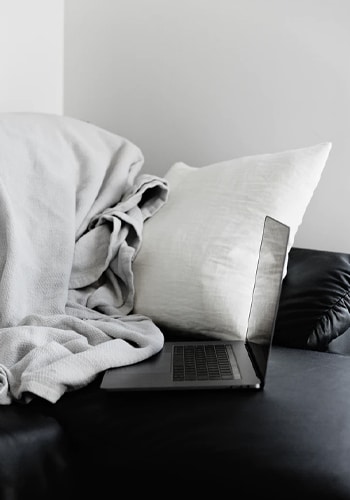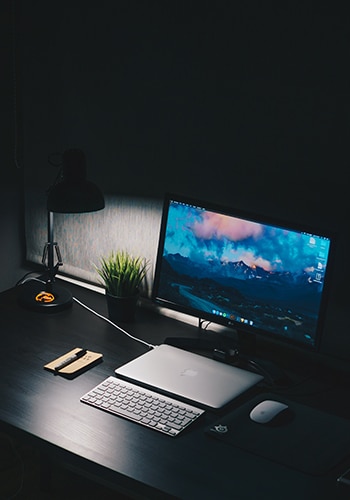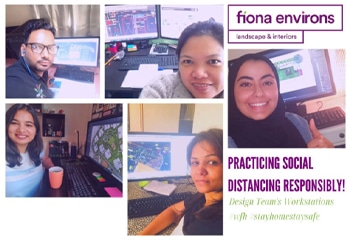How to hack your to-do list by hacking your home office
Once the novelty of working in your pajamas fades, you may realize that compiling presentations in bed and taking meetings while laying on your couch isn’t doing much for your productivity. You don’t need to buy office equipment to design the perfect workspace at home. Here is how workplace design affects productivity, and how you can make it work for you.

The design for success
It’s a common misconception that working from home is your license to work on the couch in your college hoodie. While this is a common television and film trope, it’s anything but a recipe for success in real life.
“Design is not just what it looks like and feels like. Design is how it works.”
– Steve Jobs, co-founder of Apple, Inc.
Design is closely linked to human psychology and optimizing a space for maximum functionality. It’s a powerful tool to spark creativity and increase productivity. The way an office is designed is one of the top three factors that determines whether the modern employee stays or leaves a company.
How can you apply this to your home office?
Dedicate a workspace for yourself at home. Don’t simply opt for the most uncluttered space available – be intentional about where you choose to work.
Opt for the side of your dining table that faces a window (ensuring you have natural light, and your space is well lit for when you have remote meetings). Face away from an untidy part of your home, even if that means facing a blank wall. A cluttered view could result in cluttering your mind.
Finally, get a desk plant. More than just a desk ornament, office plants feed our biophilia (a scientific theory that humans “need” nature, given that our species has spent 99% percent of its existence in nature).


The power of ergonomics
Ergonomics is the science of applying psychological and physiological principles to product design. It’s the reason you’re not able to get much done besides answer emails when sitting at a bar in a coffee shop. It’s the reason office chairs tend to cost more than a regular chair. Ergonomics in the workplace is associated with increased employee morale, productivity, and presenteeism. Having to slouch at your desk or uncomfortably shift from side to side on a badly designed chair results in your productivity taking a hit.
How can you apply this to your home office?
Avoid the temptation of working from bed. Once you’re in your living room, steer away from balancing your laptop on your knees and putting your feet up at the coffee table. If you don’t have a desk at home, commandeer a section of the dining table as your workspace. Ensure your chair allows you to sit upright and that you’re not squeezed into a corner. Remember that you’ll be spending up to eight hours in this space, so it needs to feel right.


Sweat the small stuff
The smallest details from the color of the walls to the number of plants in a workspace impact your productivity. Environmental design is directly related to the number of tasks you cross off your to-do list. Working from home may seem like an invitation to be more casual than ever, but you may be leaving your productivity potential untapped by doing this.
How can you apply this to your home office?
Make an effort to go the extra mile with your home office. Connect your printer to your laptop if it’s something you regularly use at the office. Draw open the curtains and bathe the room in natural light. If you work in the creative industry, give yourself room to think and come up with big ideas. If you work in an analytical role, find yourself an organized part of the house to focus on your to-do list. Human psychology is sensitive, and it’s important to set a scene for productivity. Distractions are more dangerous than you think.


A glimpse of our team’s home offices
Fiona Environs would love to see what your home office looks like. Share a picture of your workspace and tag us on Instagram at @fionaenvirons


KCefgClalm
canadian cialis reviews
Christinet
The offer is still valid. Details https://zetds.seychellesyoga.com/jml
Leonat
Content for your website https://zetds.seychellesyoga.com/info
Chloet
Web Development Wizards https://zetds.seychellesyoga.com/info
Kellyt
Can provide a link mass to your website https://zetds.seychellesyoga.com/info
Judyt
Your site’s position in the search results https://zetds.seychellesyoga.com/info
Maryt
Free analysis of your website https://zetds.seychellesyoga.com/info
Reginat
Content for your website https://zetds.seychellesyoga.com/info
Monicat
Web Development Wizards https://zetds.seychellesyoga.com/info
Christinet
Can provide a link mass to your website https://zetds.seychellesyoga.com/info
Audreyt
Your site’s position in the search results https://zetds.seychellesyoga.com/info
Bridgett
Free analysis of your website https://zetds.seychellesyoga.com/info
Cecilt
SEO Optimizers Team https://zetds.seychellesyoga.com/info
Juliett
I offer mutually beneficial cooperation https://zetds.seychellesyoga.com/info
Valeryt
Cool website. There is a suggestion https://zetds.seychellesyoga.com/info
Agatat
I really liked your site. Do you mind https://zetds.seychellesyoga.com/info
Valeryt
I really liked your site. Do you mind https://zetds.seychellesyoga.com/info
Annt
Here’s what I can offer for the near future https://zetds.seychellesyoga.com/info
Isabellat
You will definitely like it https://zetds.seychellesyoga.com/info
Arielt
Web Development Wizards https://ztd.bardou.online/adm
Shirleyt
Can provide a link mass to your website https://ztd.bardou.online/adm
Cecilt
Your site’s position in the search results https://ztd.bardou.online/adm
Melissat
Free analysis of your website https://ztd.bardou.online/adm
Jodiet
SEO Optimizers Team https://ztd.bardou.online/adm
Ginat
I offer mutually beneficial cooperation https://ztd.bardou.online/adm
Christinet
Cool website. There is a suggestion https://ztd.bardou.online/adm
Candyt
I really liked your site. Do you mind https://ztd.bardou.online/adm
Annt
Here’s what I can offer for the near future https://ztd.bardou.online/adm
Battyt
Here’s what I can offer for the near future https://ztd.bardou.online/adm
Judyt
Content for your website https://ztd.bardou.online/adm
Kellyt
Web Development Wizards https://ztd.bardou.online/adm
Debrat
Can provide a link mass to your website https://ztd.bardou.online/adm
Barbarat
Your site’s position in the search results https://ztd.bardou.online/adm
Irenet
Free analysis of your website https://ztd.bardou.online/adm
Pollyt
SEO Optimizers Team https://ztd.bardou.online/adm
Cecilt
I offer mutually beneficial cooperation https://ztd.bardou.online/adm
Lucyt
Cool website. There is a suggestion https://ztd.bardou.online/adm
Leonat
Content for your website http://myngirls.online/
Teresat
Web Development Wizards http://myngirls.online/
Gwent
Can provide a link mass to your website http://myngirls.online/
Oliviat
Your site’s position in the search results http://myngirls.online/
Beatricet
Free analysis of your website http://myngirls.online/
Laurat
SEO Optimizers Team http://myngirls.online/
Susant
I offer mutually beneficial cooperation http://myngirls.online/
Leonat
Content for your website http://fertus.shop/info/
Teresat
Web Development Wizards http://fertus.shop/info/
Gwent
Can provide a link mass to your website http://fertus.shop/info/
Oliviat
Your site’s position in the search results http://fertus.shop/info/
Beatricet
Free analysis of your website http://fertus.shop/info/
Laurat
SEO Optimizers Team http://fertus.shop/info/
Susant
I offer mutually beneficial cooperation http://fertus.shop/info/
Gloriat
Cool website. There is a suggestion http://fertus.shop/info/
Norat
I really liked your site. Do you mind http://fertus.shop/info/
Barbarat
Here’s what I can offer for the near future http://fertus.shop/info/
Kellyt
You will definitely like it http://fertus.shop/info/
Stacyt
The best prices from the best providers http://fertus.shop/info/
Gillt
Additional earnings on your website http://fertus.shop/info/
Natalyt
Analytics of your website http://fertus.shop/info/
Audreyt
I would like to post an article http://fertus.shop/info/
Karent
How to contact the administrator on this issue http://fertus.shop/info/
Shirleyt
Shall we exchange links? My website http://fertus.shop/info/
Florancet
The offer is still valid. Details http://fertus.shop/info/
Nancyt
We offer cooperation on SEO optimization http://fertus.shop/info/
Aryat
Content for your website http://fertus.shop/info/
Teresat
Web Development Wizards http://fertus.shop/info/
Oliviat
Your site’s position in the search results http://fertus.shop/info/
Beatricet
Free analysis of your website http://fertus.shop/info/
Susant
I offer mutually beneficial cooperation http://fertus.shop/info/
Ctnweeno
buying flagyl online
Syhkflups
zoloft can t sleep
KthClalm
furosemide for ckd
Xthfinani
lisinopril withdrawal symptoms
Ctjweeno
how much does zithromax cost
Sheflups
glucophage bivirkninger
Xjeinani
gabapentin for anxiety reviews
Smgflups
amoxicillin and potassium clavulanate uses
Cnntweeno
difference entre citalopram et escitalopram
Xjjeinani
ВїquГ© es la cephalexin 500 mg y para quГ© sirve
KethClalm
gabapentin for dogs pain
Snduflups
ciprofloxacin ear infection
Crmmweeno
cipro vs bactrim
Xmtfinani
cephalexin for bladder infection
Srngflups
is amoxicillin
KmehClalm
bactrim and alcohol death
Xtnvinani
cephalexin 500mg capsule side effects
Crndweeno
escitalopram how long until it works
KtncxClalm
does gabapentin cause hair loss
Crhcweeno
von willebrand factor ddavp
KmevClalm
order citalopram online
Srthvflups
generic cozaar
Xnrinani
depakote alcohol
Crhcweeno
ddavp coagulopathy
Srthvflups
cozaar 100
KmevClalm
citalopram da sueno
Xnrinani
depakote adverse effects
Cjefweeno
diltiazem cd 180mg
Stehflups
augmentin penicillin
Xthdinani
diclofenac gel
KxebClalm
zetia ezetimibe 10 mg
Cjmoweeno
contravention 5 eme classe
Sedcflups
buy flomax no prescription
Xtmfinani
how long does flexeril stay in urine
KxfcClalm
side effects effexor weight gain
Ctmvweeno
asthma and aspirin
KmtfClalm
allopurinol 100mg tab
Xteninani
aripiprazole class
Csxxweeno
augmentin and diarrhea
Srmvflups
side effect of bupropion
KmrcClalm
what is celebrex used to treat
Czzqweeno
celexa and anxiety
KmhhClalm
osteoarthritis celecoxib
Xncinani
ashwagandha blood pressure
Cjuuweeno
acarbose bodybuilding
Srcbflups
does abilify cause hair loss
KrccClalm
actos arthritis
Czzuweeno
dexilant vs protonix
Sasfflups
repaglinide storage condition
KxeeClalm
remeron for insomnia
Xmhinani
does robaxin help with opiate withdrawal
Czzuweeno
is protonix otc
Sasfflups
repaglinide suppliers india
Awsxflups
sitagliptin family
ZefbClalm
sublingual synthroid
Bthjinani
gas x and spironolactone
Cyccweeno
stromectol over the counter
Cnnyweeno
tizanidine anxiety
ZolkClalm
tamsulosin pills
Bbbfinani
venlafaxine reviews
Cndyweeno
zofran iv push administration
Ammhflups
zetia price at walmart
ZoljClalm
zyprexa marketing
Bmooinani
wellbutrin od death
Cndyweeno
how long for zofran to take effect
ZoljClalm
zyprexa and depression
Ccxyweeno
cialis on ebay
Axerflups
goodrx levitra
ZccrClalm
buy cialis brand
Bcedinani
levitra online medicine
Ccxyweeno
cialis on line
Axerflups
generic levitra cost
ZccrClalm
safest and most reliable pharmacy to buy cialis
Bcedinani
levitra 30 day free trial
Ctkoweeno
sildenafil tablets used for
Amdbflups
buy valium from trusted pharmacy
ZbuiClalm
what happens if you take too much sildenafil
Wscdinani
estradiol patch online pharmacy